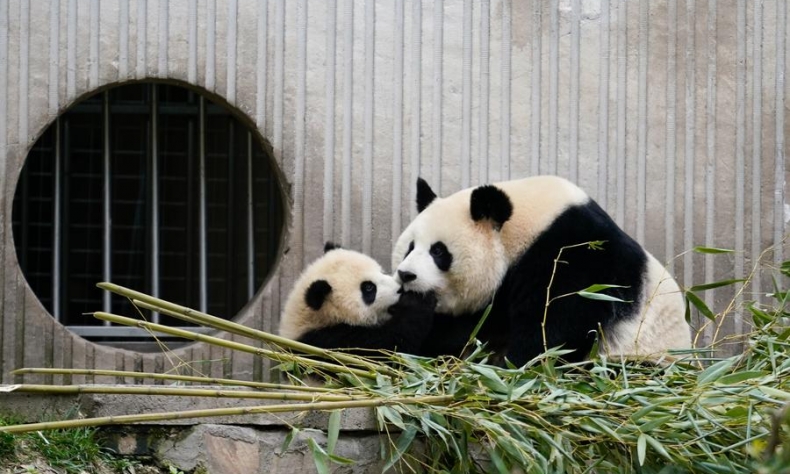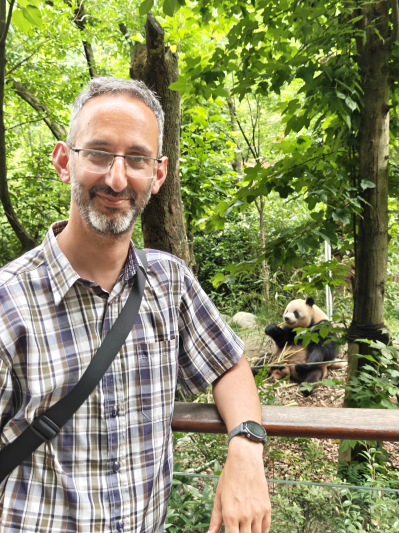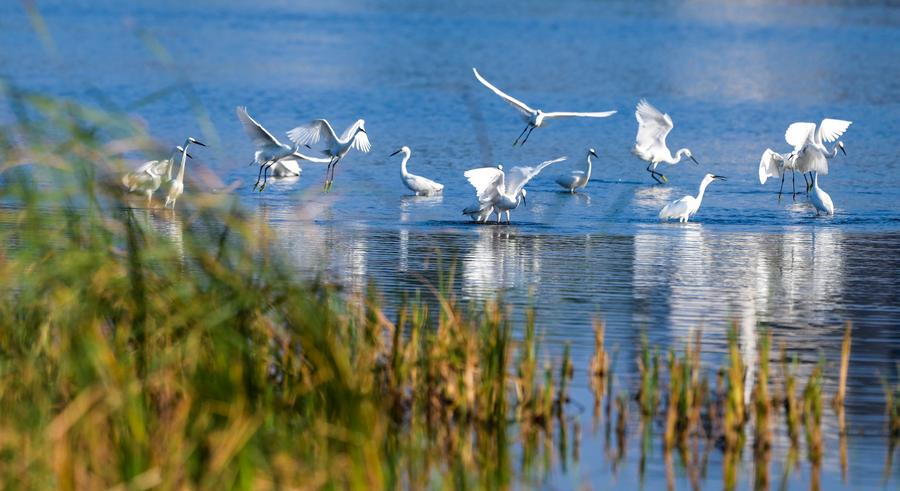Panda Progress

Through its continued innovation and untiring efforts, China is not only saving its iconic species but also contributing greatly to global biodiversity protection.
On May 21, I visited the Chengdu Research Base of Giant Panda Breeding in Chengdu, capital of the southwestern Chinese province of Sichuan. The panda sanctuary was truly impressive: vast and lush. The pandas appear happy and healthy, enjoying a huge area in which to roam freely and consume the abundant bamboo supply. Staff are clearly very dedicated to the animals’ care.
China has emerged as a global leader in wildlife conservation. In 1979, the World Wildlife Fund became the first international conservation organization to sign a cooperation agreement with China. Since that time, China’s wild giant panda population has almost doubled (to just under 2,000), thanks to extensive breeding, conservation and reforestation efforts, along with scientific advancements. Additionally, the Giant Panda National Park, consisting of 67 nature reserves and covering a vast 27,134 square km, was opened in 2020 with the express purpose of protecting the panda population.
As a result of all these efforts, the giant panda’s status has been downgraded from “endangered” to “vulnerable” on the International Union for Conservation of Nature’s Red List of Threatened Species.
China has also in recent decades strengthened protection of several other endangered species—including the Siberian tiger, Amur tiger, Tibetan antelope and Hainan gibbon—through habitat protection, artificial breeding and cultivation, and reintroduction to nature. Former UNESCO Director General Irina Bokova has said that China’s efforts in ecological protection and restoration “echo profoundly with the concept of sustainable development embodied in the United Nations Agenda 2030 (Adopted in 2015, this is a global action plan to achieve 17 Sustainable Development Goals (SDGs) by 2030—Ed.), in whose implementation China is emerging as a leader.”
Importance of biodiversity
Action on wildlife conservation and biodiversity protection is essential for a healthy planet and for human wellbeing. Balanced, thriving ecosystems contribute to climate regulation, agricultural production, pollination, nutrient cycling, medicine development, disease control, pest control and much more. Healthy ecosystems are better placed to withstand stresses such as flooding, extreme heat and invasive species, and to adapt to environmental change. As prominent British data scientist Hannah Ritchie points out in her 2024 book Not the End of the World, “From the food we eat and the fresh water we drink to the regulation of the climate: we are dependent on the balance of species around us.”
Chinese President Xi Jinping, when visiting a wildlife sanctuary in Zimbabwe in December 2015, phrased it well, “Wildlife plays a crucial role in the intricate web of life on Earth, contributing substantially to the natural ecological system. The wellbeing of these creatures is intricately intertwined with the sustainable development of humanity.”

Unfortunately, biodiversity is under severe threat as a result of climate change, deforestation, habitat loss and pollution. Scientists estimate that species loss is occurring at over 1,000 times the rate it would without human activity. Therefore, the UN SDGs include a call for governments around the world to “take urgent and significant action to reduce the degradation of natural habitats, halt the loss of biodiversity and protect and prevent the extinction of threatened species.”
Leading the way
China has taken up this call. In his address at the Opening of the High-Level Segment of Part II of the 15th Meeting of the Conference of the Parties to the Convention on Biological Diversity in 2022 via video link, Xi observed that China has made active efforts to promote biodiversity protection.
“We have continuously strengthened biodiversity mainstreaming, applied a system of ecological conservation red lines, established a protected areas system with national parks as its mainstay, carried out major biodiversity protection projects and conducted most stringent enforcement and supervision. Many rare and endangered species have been placed under effective protection, and the diversity, stability and sustainability of the ecosystem have kept improving. We have found a path of biodiversity protection with Chinese characteristics,” Xi said.
China is in the process of building the world’s largest national park system. According to He Xingyuan, a research fellow at the Institute of Applied Ecology of the Chinese Academy of Sciences, “The construction of the national park system greatly improves the protection of biodiversity and safeguards the authenticity and integrity of the ecosystem. National parks are becoming ideal homes for many rare wild animals.”
China is the world leader in afforestation, having added more forest area than any other country in recent decades—doubling forest coverage from 12 percent 40 years ago to 24 percent today. In 2024 alone, China added 7.67 million hectares of forest through tree planting and land restoration. China’s Green Great Wall project, officially known as the Three-North Shelter Forest Program, is the world’s largest afforestation project. Launched in 1978, it aims to combat desertification and soil erosion by planting over 35 million hectares of trees across northwest, north and northeast China. The project reached a major success a few months ago with the announcement that the Taklimakan, the largest desert in China and the second largest drifting desert in the world, has been completely surrounded by a green belt stretching 3,046 km, composed of drought-resistant tree species like the red willow, saxaul and desert poplar.
Meanwhile, as is well known by now, China is by far the world’s largest producer and consumer of renewable energy, responsible for over half the world’s solar and wind capacity. As such it is leading the way in the transition away from fossil fuels, and thereby mitigating the impacts of climate change and pollution on biodiversity.
China has also waged a tireless war against air, soil and water pollution, and is working hard to limit the ecological footprint of urban and industrial activities.
Ecological civilization
This progress is all part of China’s vision of ecological civilization, promoting balanced and sustainable development directed toward the harmonious coexistence of humanity and nature.

The notion of an ecological civilization is deeply rooted in Chinese tradition: Over 2,000 years ago, the Confucian philosopher Xunzi taught that “all beings flourish when they live in harmony and receive nourishment from nature.” In the modern era, China’s people-centered socialist governance is indispensable in terms of providing an appropriate economic, political and ideological framework for realizing such a vision.
Public ownership and China’s democratic planning system, among other features, have allowed China to make far more rapid progress than other major countries in relation to environmental protection and sustainable development.
Global cooperation
Consistent with the China-proposed concept of a community with a shared future for humanity, which envisions a world characterized by peace, security, prosperity, openness and sustainability achieved through international cooperation and mutual respect, China is cooperating
with countries around the world on biodiversity protection, wildlife conservation, green energy and desertification control. For example, the China-Africa Joint Research Center in Nairobi, Kenya, serves as an important platform for scientific and technological cooperation and talent cultivation between China and Kenya, as well as the African continent at large. This especially applies in areas such as biodiversity conservation, ecological environment monitoring, microbiology and modern agricultural applications.
China is actively supporting Africa’s Great Green Wall initiative, launched by the African Union in 2007, through technology transfer, aid, investment and shared expertise. The China-Africa Green Technology Park in Mauritania is a key demonstration project for the Great Green Wall and has been described by Mauritanian Minister of Environment and Sustainable Development Messouda Baham Mohamed Laghdaf as “a green revolution in the making.”
China has also been working with Brazil on satellite monitoring programs aimed at curbing deforestation and preserving biodiversity in the Amazon Rainforest.
At the 2024 Group of 20 Summit in Rio de Janeiro, Brazil, Xi made a powerful call “to support developing countries in adopting sustainable production and lifestyle, properly responding to challenges like climate change, biodiversity loss and environmental pollution, enhancing ecological conservation, and achieving harmony between human and nature.”
China’s success in panda conservation reflects a deeper commitment to preserving natural heritage as part of its broader vision for developing an ecological civilization and a Beautiful China in which “clean waters and green mountains are as valuable as gold and silver.”
Through its continued innovation and untiring efforts, the country is not only saving its iconic species but also contributing greatly to global biodiversity protection.
The author is an independent political commentator and author of The East Is Still Red: Chinese Socialism in the 21st Century (2023).
 Facebook
Facebook
 Twitter
Twitter
 Linkedin
Linkedin
 Google +
Google +










